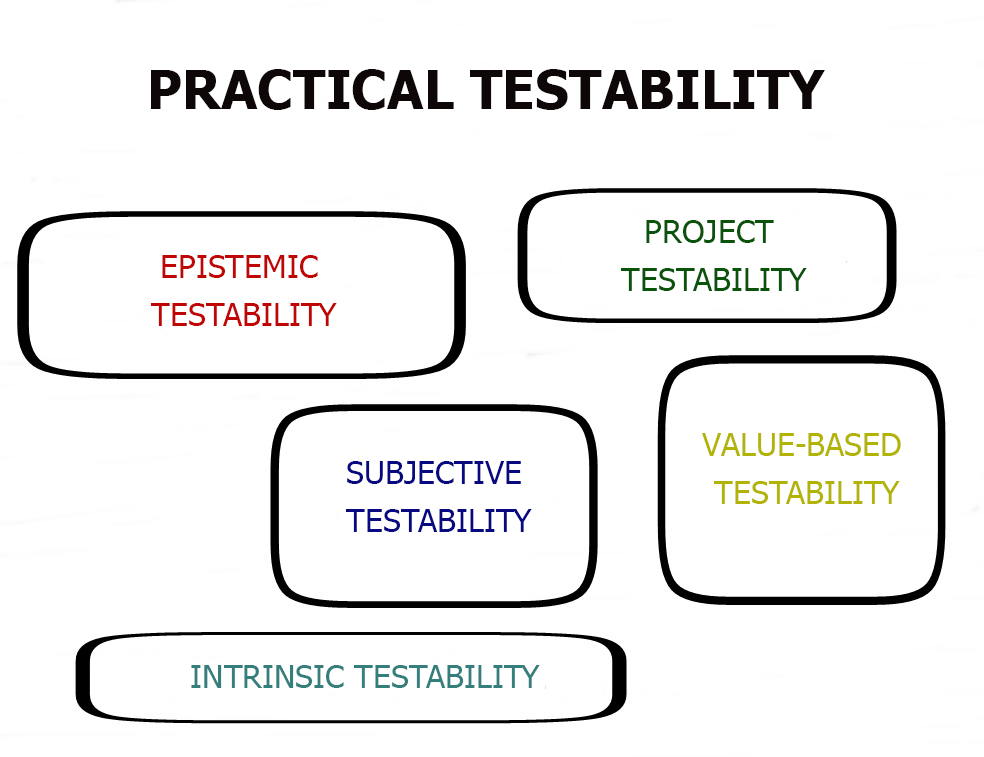The practical testability of any software is the way to see how easy it is for QA engineers to test the product when his/her work is based on a clearly defined test process within a particular project.
The practical testability is a function of 5 other testabilities: project, subjective, intrinsic, value-based, and epistemic ones. This is a very plastic concept and we cannot technically express it in one single metric.
Software Testability Dynamics
Ongoing testing of any product is certainly connected with a great number of technical problems that can be easily divided into 7 basic dynamics.
1. Reduction of the Epistemic Testability Due to the Raise of Quality Standard or Product Change
The difference between what we know and what we need to know is the most important reason why we perform testing in the first place. Undoubtedly, it is easy to test software if we already know its primary quality or if the quality level is low.
There are not so many things to test. And this is the epistemic testability of the product. Therefore, software that changes all the time or doesn’t have many bugs by default has lower testability.
2. Improving Any Other Aspect of Testability Increases the Rate of Improvement of Epistemic Testability
QA engineer makes a lot of effort to improve the aspects of testability. All of this increases the product test rate. Testers always know what they need to check and how to do it.
3. Sometimes Improving Test Strategy Decreases Subjective Testability
Such a situation may happen when tester sees that the current method of software testing isn’t effective even despite its simplicity. Improvement of the test strategy may require more technical skills than it was on a previous project with a similar test strategy.
It is significantly important to monitor the situation so you won’t implement the strategy that makes testing look easier but in fact it becomes worse.
4. Increasing Intrinsic Testability Might Decrease Project Testability
This may happen when the redesign of the site causes a lot of new bugs. Or something similar may happen when developers try to conduct the product stabilization by themselves before giving it to the QA department.
In such a situation proper Agile development may be helpful. It can minimize similar risks and technical defects.
5. Project Testability Is Also Decreased Because of Increasing Value-Based Testability
Established contact with a client sometimes can lead to a total redesign of the product and hence to re-testing. It often happens at the last stages of the project life cycle. At that time testers found main bugs but now they need to fix many new ones.
6. Increasing Practical Testability Also Improves Development and Maintenance
If is it easy to test some products, hence it is easy also to maintain, develop, and improve them.
7. QA Specialist Must Work for Testability
It is wrong to assume that software users who are not testers would consider testability seriously. Professional tester always knows where and how to find defects and what solutions to suggest while working on a project with a team.

Types of practical testability
Main Parts of Testability Analysis
Epistemic Testability
- Knowledge about quality – if we already worked with a similar product before, we will need less time to perform testing.
- Tolerance for failure – the less requirement level for the test is, the more risks can be taken by a tester.
Project Testability
- Control over current changes – big changes bring to nothing all the previous knowledge about a product and require QA engineers to re-conduct testing.
- Data availability – tester always gets all the necessary information needed to perform test qualitatively.
- Test item availability – free access to all the software versions allows a tester to interact well with a product.
- Environment control – tester controls all the experimental test environments.
- Time – lack of time damages tests. QA engineer always needs time to prepare for potential unexpected issues.
Value-Based Testability
- Unity of users – the fewer users change and the fewer differences they have, the easier develop and test the product.
- User familiarity – the more project team knows about potential users, the more it identifies with them. And obviously, the easier it is to perform testing.
- Client availability – the more ways to communicate with clients and watch on them, the easier it is to test products.
- User environment stability & unity – the fewer user environments and platforms are used to support user software and the simpler they are, the easier it is to perform testing.
Subjective Testability
- Knowledge about a product – if tester knows a lot about software (including all its features and peculiarities), then he/she can test it much better. Otherwise, if there is no information about the product, testers can quickly get it using the exploratory approach.
- Technical knowledge – the ability to program, knowledge of terminology and tools, the general concept of dynamics of software changes make the testing process much easier.
- Domain knowledge – the more QA specialist knows about a user, the better he/she test the product.
- Ability to test – improvement of such skills significantly simplifies software testing. If you use experiment design, modeling, potential product element, critical thinking, and test framing, you can bring the testing process to a completely new and more effective level.
- Engagement into the testing process – it is much easier to perform testing when QA engineer stays close to the development process and its team. Otherwise, the effectiveness of the conducted test will be at a low level.
- Test strategy – well-developed test strategy allows reducing time and efforts spent on testing.
Intrinsic Testability
- The convenience of monitoring – to test the product, QA engineer has to examine it properly. Theoretically, the software must be completely transparent so the tester can analyze and know everything about any files and various structural elements.
- The convenience of control – to perform testing correctly, specialists must be able to control the behavior of the product. Or it’s even better if they can manage a lot of input/output data that can be tested in any sequence.
- The simplicity of algorithmic – the more sensitive the product behavior is, the more tests need to be conducted by QA engineer.
- Smallness – if the software isn’t so big, it takes less time to analyze it. Also, it is less likely to miss bugs due to potential interaction among untested product components.
- The similarity to previous products – it is much easier to test the product if it is similar to the ones a tester has checked before. If software uses substantial code from a previously tested product, – that significantly reduces the time needed to perform tests.
Conclusion
To sum up, we would like to draw a line under the peculiarities of practical testability that is considered a special world with any possible criteria for software testing.
Any quality assurance organization faces the necessity to perform preliminary analysis in its daily routine: how long it will take to conduct tests, what tools are necessary, what strategies it is better to skip. Testability dynamics along with analytical components allows making a process of preliminary test evaluation more effective and correct.










Leave A Comment